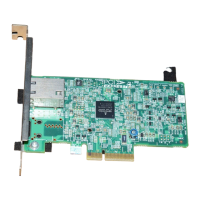IO Virtualization (IOV)BCM5718 Programmer’s Guide
Broadcom®
January 29, 2016 • 5718-PG108-R Page 263
Section 12: IO Virtualization (IOV)
IO Virtualization or IOV is a solution to transparently share a physical IO device among the child/guest OS
images in a virtualized environment. The NetXtreme (BCM5718/19/20) offers a cost efficient set of IO
Virtualization features. The following list provides the feature highlights:
• Receive Side:
• RX Traffic sorting over multiple RX queues
• Hardware assisted RX Packet replication in Driver
• Universal VLAN stripping (Not per queue based)
• 24x Perfect Match Addresses Filters
• One 128-bit MultiCast Addresses Hash Filter
• 32-Element/31-Set Programmable Protocol Filter (VLAN, TCP etc)
• 16 Receive Queues + 1 Default Queue + 1 Drop Queue
• 17 Standard Receive Producer Rings
• 17 Jumbo Receive Producer Rings
• 17 Return Rings
• Per Queue synchronization with Driver
• RX Packet Header Data Split and copy – for VMQ
• Transmit Side:
• 16 Transmit Queues for use by NetQueue or NDIS-TSS
• Per Frame Round Robin and Weighted RR scheduling in Hardware
• General:
• IOV Mode is a static configuration
• 18 MSI-X vectors – 1 per TX/RX Queue Pair
• Per Queue nominal Statistics in Hardware
• No RX Bandwidth Limitation or TX Traffic/Rate shaping
Note: No RSS support in IOV Mode.
Note: IOV shall operate in a distinct and a static chip-mode. This mode is called the IOV Mode and
the chip would need to be configured during boot-up. Once configured, the mode is irreversible unless
a hard-reset is asserted to the chip. During boot-up, if the IOV-Mode is not chosen, the chip will operate
in the Legacy Mode which is akin to the operation of previous NetXtreme devices.

